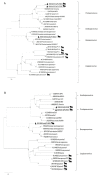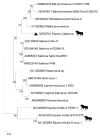New Parvoviruses and Picornavirus in Tissues and Feces of Foals with Interstitial Pneumonia
- PMID: 34452477
- PMCID: PMC8402702
- DOI: 10.3390/v13081612
New Parvoviruses and Picornavirus in Tissues and Feces of Foals with Interstitial Pneumonia
Abstract
Six foals with interstitial pneumonia of undetermined etiology from Southern California were analyzed by viral metagenomics. Spleen, lung, and colon content samples obtained during necropsy from each animal were pooled, and nucleic acids from virus-like particles enriched for deep sequencing. The recently described equine copiparvovirus named eqcopivirus, as well as three previously uncharacterized viruses, were identified. The complete ORFs genomes of two closely related protoparvoviruses, and of a bocaparvovirus, plus the partial genome of a picornavirus were assembled. The parvoviruses were classified as members of new ungulate protoparvovirus and bocaparvovirus species in the Parvoviridae family. The picornavirus was classified as a new species in the Salivirus genus of the Picornaviridae family. Spleen, lung, and colon content samples from each foal were then tested for these viral genomes by nested PCR and RT-PCR. When present, parvoviruses were detected in both feces and spleen. The picornavirus, protoparvovirus, and eqcopivirus genomes were detected in the lungs of one animal each. Three foals were co-infected with the picornavirus and either a protoparvovirus, bocaparvovirus, or eqcopivirus. Two other foals were infected with a protoparvovirus only. No viral infection was detected in one animal. The complete ORFs of the first equine protoparvoviruses and bocaparvovirus, the partial ORF of the third equine picornavirus, and their detection in tissues of foals with interstitial pneumonia are described here. Testing the involvement of these viruses in fatal interstitial pneumonia or other equine diseases will require larger epidemiological and/or inoculation studies.
Keywords: Equus caballus; cabavirus; foal; metagenomics; parvovirus; picornavirus.
Conflict of interest statement
The authors declare no conflict of interest.
Figures


Similar articles
-
Viruses in Horses with Neurologic and Respiratory Diseases.Viruses. 2019 Oct 14;11(10):942. doi: 10.3390/v11100942. Viruses. 2019. PMID: 31614994 Free PMC article.
-
A highly divergent picornavirus in an amphibian, the smooth newt (Lissotriton vulgaris).J Gen Virol. 2015 Sep;96(9):2607-2613. doi: 10.1099/vir.0.000198. Epub 2015 May 26. J Gen Virol. 2015. PMID: 26018961 Free PMC article.
-
Characterization and phylogenetic analysis of a novel picornavirus from swine feces in Japan.Arch Virol. 2016 Jun;161(6):1685-90. doi: 10.1007/s00705-016-2834-7. Epub 2016 Mar 26. Arch Virol. 2016. PMID: 27016931
-
Equine picornaviruses: well known but poorly understood.Vet Microbiol. 2013 Nov 29;167(1-2):78-85. doi: 10.1016/j.vetmic.2013.05.012. Epub 2013 Jun 10. Vet Microbiol. 2013. PMID: 23820049 Review.
-
Saliviruses-the first knowledge about a newly discovered human picornavirus.Rev Med Virol. 2017 Jan;27(1). doi: 10.1002/rmv.1904. Epub 2016 Sep 19. Rev Med Virol. 2017. PMID: 27641729 Review.
Cited by
-
Newlavirus, a Novel, Highly Prevalent, and Highly Diverse Protoparvovirus of Foxes (Vulpes spp.).Viruses. 2021 Sep 30;13(10):1969. doi: 10.3390/v13101969. Viruses. 2021. PMID: 34696399 Free PMC article.
-
Investigation of Three Newly Identified Equine Parvoviruses in Blood and Nasal Fluid Samples of Clinically Healthy Horses and Horses with Acute Onset of Respiratory Disease.Animals (Basel). 2021 Oct 19;11(10):3006. doi: 10.3390/ani11103006. Animals (Basel). 2021. PMID: 34680025 Free PMC article.
-
Frequency of Detection and Prevalence Factors Associated with Common Respiratory Pathogens in Equids with Acute Onset of Fever and/or Respiratory Signs (2008-2021).Pathogens. 2022 Jul 2;11(7):759. doi: 10.3390/pathogens11070759. Pathogens. 2022. PMID: 35890002 Free PMC article.
-
The Structures and Functions of Parvovirus Capsids and Missing Pieces: the Viral DNA and Its Packaging, Asymmetrical Features, Nonprotein Components, and Receptor or Antibody Binding and Interactions.J Virol. 2023 Jul 27;97(7):e0016123. doi: 10.1128/jvi.00161-23. Epub 2023 Jun 27. J Virol. 2023. PMID: 37367301 Free PMC article. Review.
-
Novel Virus Identification through Metagenomics: A Systematic Review.Life (Basel). 2022 Dec 7;12(12):2048. doi: 10.3390/life12122048. Life (Basel). 2022. PMID: 36556413 Free PMC article. Review.

